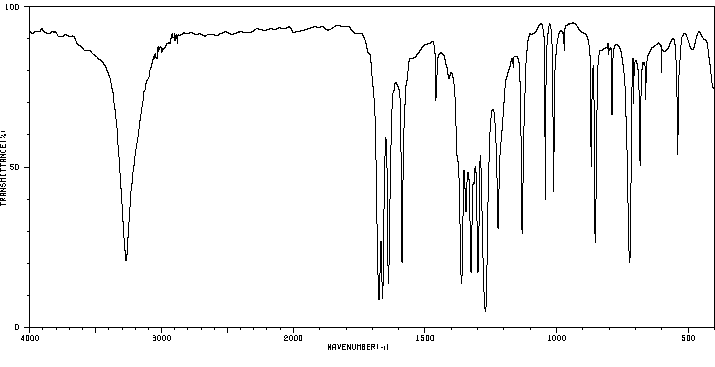3-chloro-4-hydroxynaphthalene-1,2-dione | 1526-73-4
中文名称
——
中文别名
——
英文名称
3-chloro-4-hydroxynaphthalene-1,2-dione
英文别名
3-chloro-2-hydroxy-naphthalene-1,4-dione;3-chloro-1,4-dihydro-1,4-dioxo-2-hydroxynaphthalene;2-chloro-3-hydroxy-[1,4]-naphthoquinone;2-chloro-3-hydroxynaphthalene-1,4-dione;2-chloro-3-hydroxy-1,4-naphthoquinone;2-hydroxy-3-chloro-1,4-naphthoquinone;3-chloro-2-hydroxy-1,4-naphthoquinone
CAS
1526-73-4
化学式
C10H5ClO3
mdl
MFCD00043767
分子量
208.601
InChiKey
FIGWNRLKJUUMTF-UHFFFAOYSA-N
BEILSTEIN
——
EINECS
——
-
物化性质
-
计算性质
-
ADMET
-
安全信息
-
SDS
-
制备方法与用途
-
上下游信息
-
文献信息
-
表征谱图
-
同类化合物
-
相关功能分类
-
相关结构分类
物化性质
-
熔点:216.5°C
-
沸点:299.56°C (rough estimate)
-
密度:1.3609 (rough estimate)
计算性质
-
辛醇/水分配系数(LogP):1.36
-
重原子数:14.0
-
可旋转键数:0.0
-
环数:2.0
-
sp3杂化的碳原子比例:0.0
-
拓扑面积:54.37
-
氢给体数:1.0
-
氢受体数:3.0
安全信息
-
海关编码:2914700090
SDS
上下游信息
-
上游原料
中文名称 英文名称 CAS号 化学式 分子量 2-氯-3-甲氧基-1,4-萘醌 2-chloro-3-methoxy-1,4-naphthoquinone 15707-32-1 C11H7ClO3 222.628 —— 2-chloro-3-<7-<2-chloro-3-(1,4-naphthoquinone-2-yl)>-1,4,7-trioxaheptyl>-1,4-napthoquinone 101974-92-9 C24H16Cl2O7 487.293 —— 2-acetoxy-3-chloro-1,4-naphthoquinone 17205-33-3 C12H7ClO4 250.638 2-羟基-1,4-萘醌 lawsone 83-72-7 C10H6O3 174.156 2,3-二氯-1,4-萘醌 2,3-Dichloro-1,4-naphthoquinone 117-80-6 C10H4Cl2O2 227.047 —— 3-bromo-4-hydroxynaphthalene-1,2-dione 1203-39-0 C10H5BrO3 253.052 2-氨基-3-氯-1,4-萘醌 quinoclamine 2797-51-5 C10H6ClNO2 207.616 2-二甲氨基-3-氯-1,4-萘并醌 2-chloro-3-dimethylamino-1,4-naphthoquinone 5350-26-5 C12H10ClNO2 235.67 N-(3-氯-1,4-二氢-1,4-二氧代-2-萘基)乙酰胺 2-acetamido-3-chloro-1,4-naphthoquinone 5397-78-4 C12H8ClNO3 249.653 —— 3-chloro-2-(piperazin-1-yl)-1,4-naphthoquinone 104309-89-9 C14H13ClN2O2 276.722 -
下游产品
中文名称 英文名称 CAS号 化学式 分子量 2-氯-3-甲氧基-1,4-萘醌 2-chloro-3-methoxy-1,4-naphthoquinone 15707-32-1 C11H7ClO3 222.628 —— 2-acetoxy-3-chloro-1,4-naphthoquinone 17205-33-3 C12H7ClO4 250.638 —— 3-Chloro-1,4-dioxo-1,4-dihydronaphthalen-2-yl propanoate 91270-24-5 C13H9ClO4 264.66 2-羟基-1,4-萘醌 lawsone 83-72-7 C10H6O3 174.156 N-(4-硝基-2-((三氟甲基)磺酰基)苯基)乙酰胺 N-(4-nitro-2-((trifluoromethyl)sulfonyl)phenyl)acetamide 54941-03-6 C16H11NO3 265.268
反应信息
-
作为反应物:描述:参考文献:名称:Regiocontrolled synthesis and HIV inhibitory activity of unsymmetrical binaphthoquinone and trimeric naphthoquinone derivatives of conocurvone摘要:Unsymmetrical biquinone and trimeric quinone derivatives were synthesized using halotriflate-biselectrophilic naphthoquinones through stepwise regioselective quinone substitution chemistry and evaluated for their ability to inhibit the cytopathogenic effects of HIV-1 using an MTT colorimetric assay. Compounds were also screened for their ability to inhibit the activity of HIV-1 integrase in vitro. Pyranylated trimeric quinones and biquinones exhibited both antiviral activity and integrase inhibitory activity. Conocurvone 1 and trimeric quinone 21 were the most potent HIV integrase inhibitors in the series. All of the biquinones showed HIV inhibitory activity. Simple methoxy substituted biquinones did not inhibit HIV-1 integrase. Published by Elsevier Ltd.DOI:10.1016/j.bmc.2006.04.034
-
作为产物:参考文献:名称:Zincke; Kegel, Chemische Berichte, 1888, vol. 21, p. 3552摘要:DOI:
文献信息
-
Design, Synthesis and Antimalarial Activity of Some New 2-Hydroxy-1,4-naphthoquinone-4-hydroxyaniline Hybrid Mannich Bases作者:Dipshikha Sharma、Dipak Chetia、Mithun RudrapalDOI:10.14233/ajchem.2016.19478日期:——In this study, some novel 2-hydroxy-1,4-naphthoquinone-4-hydroxyaniline hybrid Mannich bases were designed, synthesized and evaluated for in vitro antimalarial activity. The design strategy of novel hybrid molecules involves fusion between the pharmacophoric moieties of lawsone (2-hydroxy-1,4-naphthoquinone, a residue from atovaquone) and Mannich substituted 4-hydroxyaniline (4-aminophenol, a residue from amodiaquine) on the basis of molecular hybridization strategy. Newly designed compounds, 5a-f were also studied for drug-likeness assessment based on Lipinski’s rule of five. All the synthesized compounds exhibited some degree of in vitro antimalarial activity against the chloroquine-sensitive strain (RKL-2) of P. falciparum at the tested dose (1 mg/mL), which was considerably less than that of the standard drug, chloroquine (0.1 mg/mL). However, compounds with propyl, 5a (IC50 0.453 μg/mL) and morpholinyl, 5f (IC50 0.391 μg/mL) substitutions showed comparatively better activity than rest of the synthesized analogues. Compound 5f (IC50 0.993 μg/mL) was found to possess higher antimalarial effectiveness than compound 5a (IC50 2.92 μg/mL) against resistant strain (RKL-9) of P. falciparum. The activity of these compounds against the resistant strain was also less than that of chloroquine (IC50 0.299 μg/mL). From results, it is clear that compounds having substitutions like smaller alkyl groups (n-propyl, 5a; isopropyl, 5b) or saturated heterocyclic moiety (morpholinyl, 5f) possess superior antimalarial activity in comparison to other compounds substituted with bulky alkyl (diisopropyl, 5c; n-butyl, 5d) or aryl (phenyl, 5e) moieties. Further, since all the compounds exhibited favourable drug-like properties a reasonable correlation therefore appears to exist between their drug-likeness and antimalarial activities.在本研究中,我们设计、合成了一些新颖的2-羟基-1,4-萘醌-4-羟基苯胺杂化Mannich碱,并评估了它们在体外抗疟活性。新型杂化分子设计策略涉及基于分子杂交策略将lawhone(2-羟基-1,4-萘醌,阿托喹酮的残留部分)和 Mannich取代的4-羟基苯胺(4-氨基苯酚,阿莫地喹的残留部分)的药效团部分融合。根据Lipinski的五规则,还研究了新设计的化合物5a-f的类药性评估。所有合成的化合物在测试剂量(1 mg/mL)下对氯喹敏感的P. falciparum菌株(RKL-2)显示出一定程度的体外抗疟活性,这远低于标准药物氯喹(0.1 mg/mL)的活性。然而,具有丙基、5a(IC50 0.453 μg/mL)和吗啉基、5f(IC50 0.391 μg/mL)取代的化合物显示出相对较好的活性相比其他合成的类似物。化合物5f(IC50 0.993 μg/mL)对耐药菌株(RKL-9)的P. falciparum具有比化合物5a(IC50 2.92 μg/mL)更高的抗疟效果。这些化合物对耐药菌株的活性也低于氯喹(IC50 0.299 μg/mL)。从结果中可以清楚地看出,与其他用大体积烷基(二异丙基,5c;正丁基,5d)或芳基(苯基,5e)取代的化合物相比,具有较小烷基(正丙基,5a;异丙基,5b)或饱和杂环基团(吗啉基,5f)取代的化合物具有更优越的抗疟活性。此外,由于所有化合物都表现出良好的类药性,因此它们与抗疟活性之间似乎存在合理相关性。
-
[EN] NAPTHOQUINONES, PRO-DRUGS, AND METHODS OF USE THEREOF<br/>[FR] NAPHTOQUINONES, PROMÉDICAMENTS, ET LEURS PROCÉDÉS D'UTILISATION申请人:UNIV TEXAS公开号:WO2017106624A1公开(公告)日:2017-06-22Provided herein are naphthoquinones compounds such as those with a hydrogen bond donating group of the formula (I): wherein: R1, R2, R3, R4, R5, and n are as defined herein. Also provided herein are pharmaceutical composition of the present compounds and methods of treatment using the compounds including their use in the treatment of cancer.提供在本说明书中的萘醌化合物,例如具有式(I)中的氢键供体基团的那些:其中:R1、R2、R3、R4、R5和n如本文所述定义。此外,还提供了本化合物的药物组合物以及使用这些化合物进行治疗的方法,包括它们在癌症治疗中的应用。
-
Chlorination of Quinonoid Compounds Using Dichlorine Monoxide
-
Sulfur-containing derivatives of 1,4-naphthoquinone, part 1: Disulfide synthesis作者:Maryna V. Stasevych、Maxym Yu. Plotnikov、Mykola O. Platonov、Svitlana I. Sabat、Rostyslav Ya. Musyanovych,、Volodymyr P. NovikovDOI:10.1002/hc.20112日期:——Disulfides of 1,4-naphthoquinone were synthesized, and different methods of their synthesis were investigated. High yields and purity of disulfides were obtained from the oxidation of thiol derivatives. The latter were prepared in high yields and purity from isothiuronic salts. The obtained disulfides are syntho- nes for compounds with a wide spectrum of biological activity. © 2005 Wiley Periodicals
-
Molecular structures and biological activities of (N)-n-alkylammonium 2-chloro-3-oxido-1,4-naphthoquinone salts作者:Dinkar Choudhari、Dipali N. Lande、Aditi Bagade、Shridhar P. Gejji、Debamitra Chakravarty、Kisan M. Kodam、Sunita Salunke-GawaliDOI:10.1016/j.molstruc.2017.05.083日期:2017.10structures and vibrational spectra of (N)-n-alkylammonium 2-chloro-3-oxido-1,4-naphthoquinone salts (alkyl = methyl to octyl, CS-1 to CS-8) possessing X-H⋯Y (X = N, C and Y O, Cl) hydrogen bonding and diverse noncovalent interactions have been characterized. Except for the CS-2 and CS-7 rest of the compounds facilitate π⋯π and Cl⋯π interactions. The compound CS-3 showed the presence of Cl⋯O interactions摘要 具有 XH⋯的 (N)-n-烷基铵 2-chloro-3-oxido-1,4-naphthoquinone 盐(烷基 = 甲基到辛基,CS-1 到 CS-8)的单晶 X 射线结构和振动光谱Y (X = N, C 和 YO, Cl) 氢键和多种非共价相互作用已被表征。除了 CS-2 和 CS-7 之外,其余化合物促进 π⋯π 和 Cl⋯π 相互作用。化合物CS-3表现出Cl⋯O相互作用的存在。得到的电子结构和光谱特性与密度泛函理论一致。这些复合物显示出显着的抗增殖和抗真菌活性。
表征谱图
-
氢谱1HNMR
-
质谱MS
-
碳谱13CNMR
-
红外IR
-
拉曼Raman
-
峰位数据
-
峰位匹配
-
表征信息
同类化合物
(S)-溴烯醇内酯
(R)-3,3''-双([[1,1''-联苯]-4-基)-[1,1''-联萘]-2,2''-二醇
(3S,3aR)-2-(3-氯-4-氰基苯基)-3-环戊基-3,3a,4,5-四氢-2H-苯并[g]吲唑-7-羧酸
(3R,3’’R,4S,4’’S,11bS,11’’bS)-(+)-4,4’’-二叔丁基-4,4’’,5,5’’-四氢-3,3’’-联-3H-二萘酚[2,1-c:1’’,2’’-e]膦(S)-BINAPINE
(11bS)-2,6-双(3,5-二甲基苯基)-4-羟基-4-氧化物-萘并[2,1-d:1'',2''-f][1,3,2]二氧磷
(11bS)-2,6-双(3,5-二氯苯基)-4羟基-4-氧-二萘并[2,1-d:1'',2''-f][1,3,2]二氧磷杂七环
(11bR)-2,6-双[3,5-双(1,1-二甲基乙基)苯基]-4-羟基-4-氧化物-二萘并[2,1-d:1'',2''-f][1,3,2]二氧杂磷平
黄胺酸
马兜铃对酮
马休黄钠盐一水合物
马休黄
食品黄6号
食品红40铝盐色淀
飞龙掌血香豆醌
颜料黄101
颜料红70
颜料红63
颜料红53:3
颜料红5
颜料红48单钠盐
颜料红48:2
颜料红4
颜料红261
颜料红258
颜料红220
颜料红22
颜料红214
颜料红2
颜料红19
颜料红185
颜料红184
颜料红170
颜料红148
颜料红147
颜料红146
颜料红119
颜料红114
颜料红 9
颜料红 21
颜料橙7
颜料橙46
颜料橙38
颜料橙3
颜料橙22
颜料橙2
颜料橙17
颜料橙 5
颜料棕1
顺式-阿托伐醌-d5
雄甾烷-3,17-二酮








